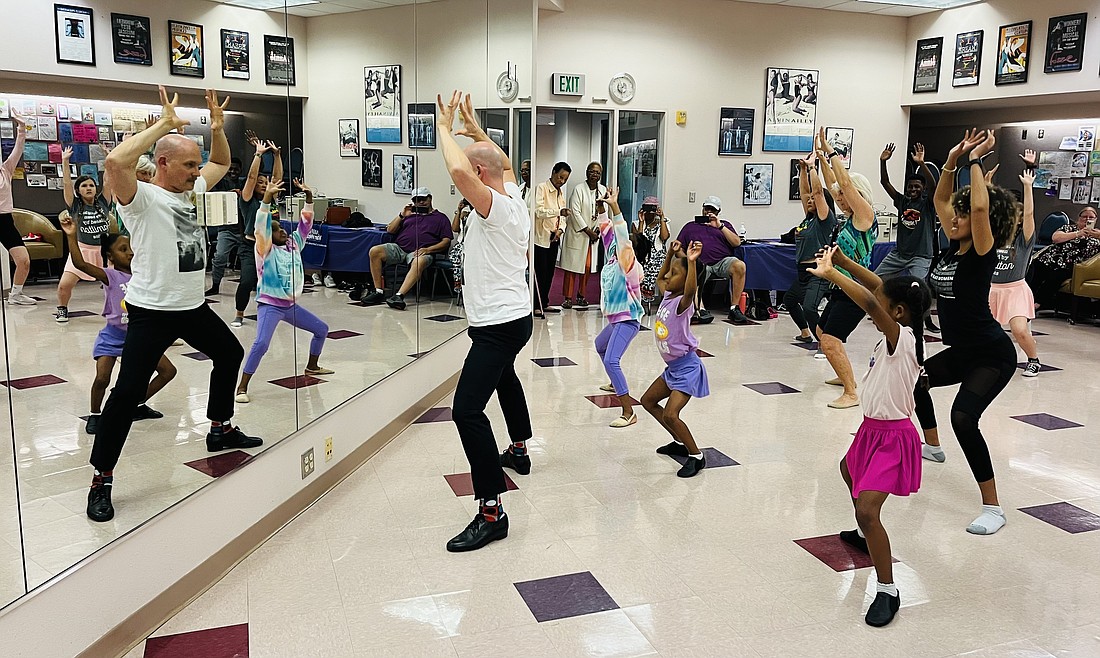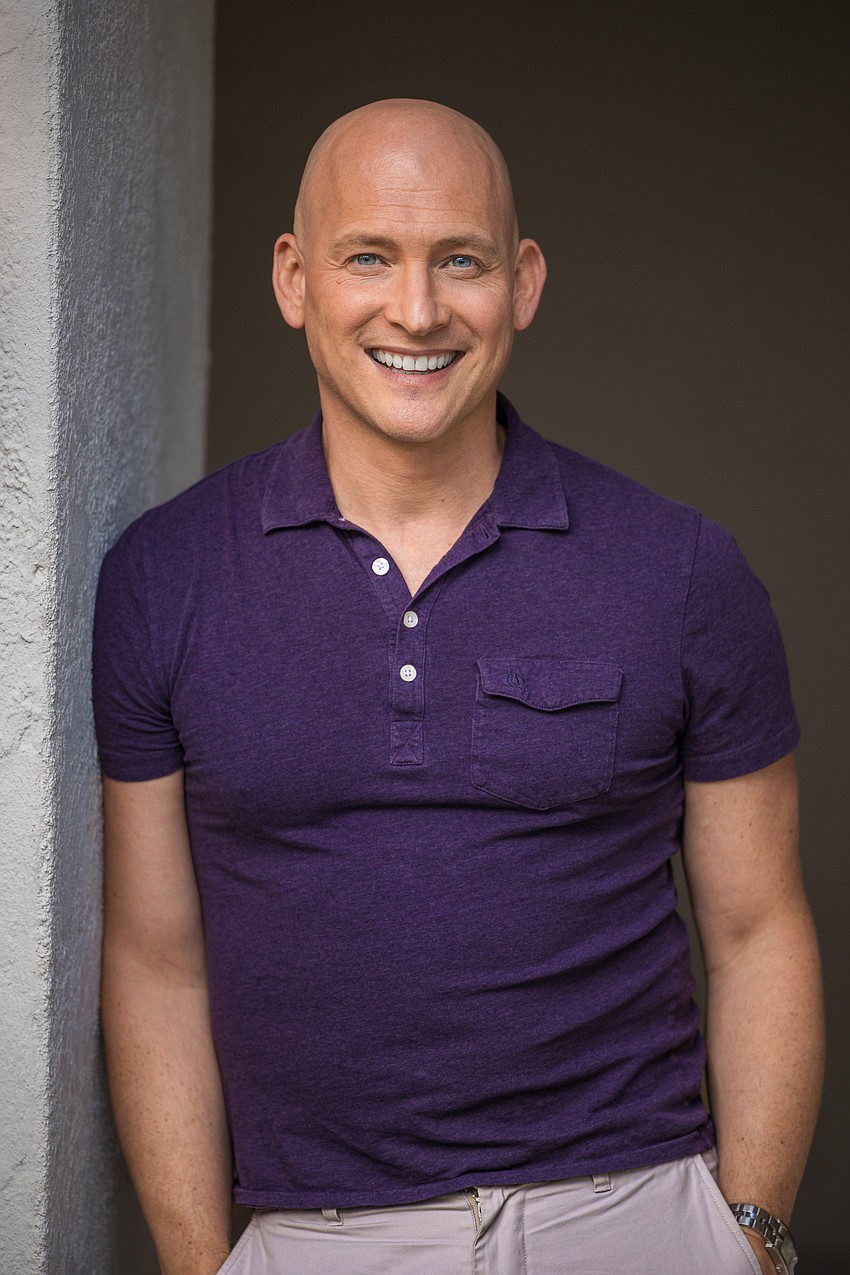- May 16, 2025
-
-
Loading

Loading

Truth be told, Justin Gomlak, director of education at the Van Wezel Performing Arts Hall, had a hard time following a March 7 presentation at The Ora on “Hamilton vs. Jefferson: The Rivalry That Shaped America.”
The talk by Louis Masur, the board of governors distinguished professor of American studies and history at Rutgers University, was a tough act to follow. It was nearly two hours long and it was time for lunch when Masur finished.
Being the trouper he is, Gomlak took the audience departures in stride. He continued to speak passionately about a subject close to his heart — accessibility in the performing arts.
Maybe if Gomlak had put on his dancing shoes and started to sing tunes from “Hamilton” the way he did at a March 28 master class at the Van Wezel, the Ora crowd would have been more receptive.
Students at Gomlak’s Van Wezel studio, tucked away on the second floor of the building lovingly dubbed “The Purple Cow,” were attentive listeners. For the class, Gomlak had choreographed energetic, but not demanding, dance sequences to accompany songs from “Hamilton,” which runs at the Van Wezel through Sunday, April 7.
While the focus was more on dancing than singing, the students of varying ages and abilities had done their homework. They knew the words to “Hamilton” songs like “The Room Where It Happens,” “The Schuyler Sisters,” “Helpless” and “Take a Break.”
For those who haven’t seen “Hamilton” and wonder why it has such long “legs” — theater speak for longevity — it should be mentioned the enduring hip-hop musical has an astounding 46 songs. Surely, it would be impossible to know the words to all of them, but based on Gomlak’s class, some people just might.

Watching Gomlak teach his master class is to be swept up in the magic of Broadway. His enthusiasm, supple movements and elastic facial expressions transport you to another world. Gomlak’s stage persona immediately prompts those watching the class to remark, “Isn’t he darling?” He is.
Here’s the real trick. Gomlak makes you think you might be able to move the way he does. “It doesn’t matter what your body looks like, how much experience you have,” Gomlak advises his class of about 30 students. “What matters in musical stage is storytelling. Anyone can tell a story.”
As the posters on the walls of his studio attest, Gomlak knows a little something about Broadway. His credits include the Tony Award-winning revival of “Anything Goes,” “The Producers” (the “Hamilton” of its day), “Annie,” “Seussical the Musical” and “Shrek the Musical,” to name a few. It’s telling that Gomlak has been in several productions aimed at children because in some ways, he seems like a kid himself.
Gomlak lets students at the master classes know about his Broadway street cred, but he moves lightly over his 15 years on the Great White Way. He keeps the hourlong classes focused on his students and on the musicals that will be playing the Van Wezel.
Is Gomlak’s job as director of education at the Van Wezel marketing or community outreach? It’s a little of both. As befitting a longtime showman, Gomlak wears many hats. Besides teaching and representing the Van Wezel at community events, he oversees programs like school performances, professional development workshops and family nights at the Van Wezel.
Before joining the Van Wezel’s staff in May 2022, Gomlak was the arts department chair at the Dalton School in New York City. At Dalton, Gomlak put in place diversity, equity and inclusion and social emotional learning programs schoolwide, in addition to teaching 400 students weekly.
It’s often assumed that people who end up on stage are natural hams. That wasn’t the case for Gomlak, who describes himself as an introvert in his youth.
“When I was doing plays, I was a shy person,” he recalls. “But the experience of inhabiting someone else’s skin, it was like a shield for me. I was able to do all of the things that the regular Justin was too shy to do.”
When Gomlak talks about his life’s trajectory, one gets the impression that an invisible hand steered him in at key points in his life. When he was growing up in a rural area in Western New York outside Buffalo (“there were a lot of chickens around”), Gomlak says there weren’t a lot of role models for a boy interested in the performing arts.
Although he didn’t want to be the center of attention growing up, he played piano and developed his voice by singing with choirs. He performed in high school musicals, and would get depressed when they ended because he had to go back to ordinary life.
When it came time to apply for college, Gomlak wasn’t sure what would be the right school for him, when fate intervened. “One of the mothers at a summer choir said ‘You should look at Carnegie Mellon.’ I auditioned and I got in. It’s a very good school. I stumbled upon it through a message from universe,” Gomlak says.
His talent and Carnegie Mellon contacts led him to a successful career on Broadway. But as he approached 40, Gomlak knew he was aging out of musical theater roles.
He began working to develop a career as an educator by doing residencies at school. One day, he received a call from “an admissions director at a fancy-schmancy school” offering him a job. In case you missed it, the school was Dalton.
While the title of his current job has the word “education” in it, Gomlak says he’s never done anything quite like it before. “It melds these two worlds. It’s working in commercial theater and melding that with education,” he says.
To be clear, the Van Wezel is owned by the city of Sarasota, so Gomlak is a government, not a corporate, employee. But the Van Wezel is involved in the business of entertainment and selling as many tickets as possible.
As Gomlak told the crowd at The Ora in March, he is passionate about accessibility. In his job at the Van Wezel, he gets to put his beliefs into action. His mission isn’t about just bringing shows to disabled audiences, but allowing them to participate in the performing arts.
Working in conjunction with the Tampa group Revolutions Dance, Gomlak developed a piece called “Revolutionary Moves: Defying Limits Through Dance.”
“We reframed the idea that if you are in a wheelchair you can’t do anything,” Gomlak says. “We tell them, ‘That wheelchair is a tool. You can use it in lots of different ways. It can enhance what is possible.’ The message is powerful to a kid in a wheelchair.”